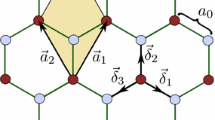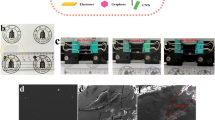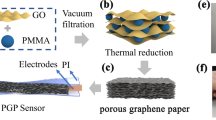Abstract
Human motion detection needs sensors with flexibility, high sensitivity and linearity. However, conventional strain sensors are rigid and not suitable for human motion detection applications. Graphene-based strain sensors can overcome the above challenges but currently are still in the infancy of their development. In this work, properties of graphene-based crack-type strain sensors are investigated and guidelines to improve the sensitivity of graphene films as sensing elements are developed. First, it is found that the pre-strains influences the crack morphology and density, which further results in different sensor sensitivities and linearity. Second, the graphene film thickness influences the crack density due to the sliding between graphene layers; namely, a thinner graphene film with more cracks exhibits higher sensitivity. Third, the substrate influences the bonding strength with the graphene film, leading to different crack formations, which results in adjusted sensitivity. The cracks on PDMS are channel cracks while those on epoxy are isolated short cracks. The channel cracks are preferred to cause high sensitivity while the isolated short cracks hardly have a blocking effect on the current transport. Finally, the optimized graphene strain sensors are used to detect various human motions and exhibit high sensitivity.
Similar content being viewed by others
References
Ray T R, Choi J, Bandodkar A J, et al. Bio-integrated wearable systems: A comprehensive review. Chem Rev, 2019, 119: 5461–5533
Jung Y H, Park B, Kim J U, et al. Bioinspired electronics for artificial sensory systems. Adv Mater, 2019, 31: 1803637
Bai N, Wang L, Wang Q, et al. Graded intrafillable architecture-based iontronic pressure sensor with ultra-broad-range high sensitivity. Nat Commun, 2020, 11: 209
Hempel M, Nezich D, Kong J, et al. A novel class of strain gauges based on layered percolative films of 2D materials. Nano Lett, 2012, 12: 5714–5718
Chen Z, Ming T, Goulamaly M M, et al. Enhancing the sensitivity of percolative graphene films for flexible and transparent pressure sensor arrays. Adv Funct Mater, 2016, 26: 5061–5067
Long Y, He P, Xu R, et al. Molybdenum-carbide-graphene composites for paper-based strain and acoustic pressure sensors. Carbon, 2020, 157: 594–601
Yang T T, Wang W, Zhang H Z, et al. Tactile sensing system based on arrays of graphene woven microfabrics: Electromechanical behavior and electronic skin application. ACS Nano, 2015, 9: 10867–10875
Yang T, Xie D, Li Z, et al. Recent advances in wearable tactile sensors: Materials, sensing mechanisms, and device performance. Mater Sci Eng-R-Rep, 2017, 115: 1–37
Li B, Luo J, Huang X, et al. A highly stretchable, super-hydrophobic strain sensor based on polydopamine and graphene reinforced nanofiber composite for human motion monitoring. Compos Part B-Eng, 2020, 181: 107580
Sengupta D, Pei Y, Kottapalli A G P. Ultralightweight and 3D squeezable graphene-polydimethylsiloxane composite foams as piezoresistive sensors. ACS Appl Mater Interfaces, 2019, 11: 35201–35211
Jia Y, Chen W, Ye C, et al. Controllable formation of periodic wrinkles in marangoni-driven self-assembled graphene film for sensitive strain detection. Sci China Mater, 2020, 63: 1983–1992
Leem J, Lee Y, Wang M C, et al. Crack-assisted, localized deformation of van der waals materials for enhanced strain confinement. 2D Mater, 2019, 6: 044001
Xue P, Chen C, Diao D. Ultra-sensitive flexible strain sensor based on graphene nanocrystallite carbon film with wrinkle structures. Carbon, 2019, 147: 227–235
Kang D, Pikhitsa P V, Choi Y W, et al. Ultrasensitive mechanical crack-based sensor inspired by the spider sensory system. Nature, 2014, 516: 222–226
Yang T, Li X, Jiang X, et al. Structural engineering of gold thin films with channel cracks for ultrasensitive strain sensing. Mater Horiz, 2016, 3: 248–255
Han Z, Liu L, Zhang J, et al. High-performance flexible strain sensor with bio-inspired crack arrays. Nanoscale, 2018, 10: 15178–15186
Liu G S, Yang F, Xu J, et al. Ultrasonically patterning silver nanowire-acrylate composite for highly sensitive and transparent strain sensors based on parallel cracks. ACS Appl Mater Interfaces, 2020, 12: 47729–47738
Chen S, Wei Y, Wei S, et al. Ultrasensitive cracking-assisted strain sensors based on silver nanowires/graphene hybrid particles. ACS Appl Mater Interfaces, 2016, 8: 25563–25570
Liao X, Zhang Z, Liao Q, et al. Flexible and printable paper-based strain sensors for wearable and large-area green electronics. Nanoscale, 2016, 8: 13025–13032
Song H, Zhang J, Chen D, et al. Superfast and high-sensitivity printable strain sensors with bioinspired micron-scale cracks. Nanoscale, 2017, 9: 1166–1173
Mao L, Gong T, Ai Q, et al. Morphologically modulated laser-patterned reduced graphene oxide strain sensors for human fatigue recognition. Smart Mater Struct, 2020, 29: 015009
Xiao Y, Jiang S, Li Y, et al. Highly sensitive printed crack-enhanced strain sensor as dual-directional bending detector. Smart Mater Struct, 2020, 29: 045023
Chun S, Choi Y, Park W. All-graphene strain sensor on soft substrate. Carbon, 2017, 116: 753–759
Gong S, Yap L W, Zhu Y, et al. A soft resistive acoustic sensor based on suspended standing nanowire membranes with point crack design. Adv Funct Mater, 2020, 30: 1910717
Dinh Le T S, An J, Huang Y, et al. Ultrasensitive anti-interference voice recognition by bio-inspired skin-attachable self-cleaning acoustic sensors. ACS Nano, 2019, 13: 13293–13303
Yang T, Wang W, Huang Y, et al. Accurate monitoring of small strain for timbre recognition via ductile fragmentation of functionalized graphene multilayers. ACS Appl Mater Interfaces, 2020, 12: 57352–57361
Hummers Jr. W S, Offeman R E. Preparation of graphitic oxide. J Am Chem Soc, 1958, 80: 1339
Marcano D C, Kosynkin D V, Berlin J M, et al. Improved synthesis of graphene oxide. ACS Nano, 2010, 4: 4806–4814
Huang Y, Li J, Xiang Y, et al. Asymmetrical layered assemblies of graphene oxide for programmable actuation devices. Smart Mater Struct, 2020, 29: 115048
Huang Y, Yao Q, Qi Y, et al. Wear evolution of monolayer graphene at the macroscale. Carbon, 2017, 115: 600–607
Park B, Kim J, Kang D, et al. Dramatically enhanced mechanosensitivity and signal-to-noise ratio of nanoscale crack-based sensors: Effect of crack depth. Adv Mater, 2016, 28: 8130–8137
Park B, Lee S, Choi H, et al. A semi-permanent and durable nanoscale-crack-based sensor by on-demand healing. Nanoscale, 2018, 10: 4354–4360
Kwon Y, Park C, Kim J, et al. Effects of bending strain and crack direction on crack-based strain sensors. Smart Mater Struct, 2020, 29: 115007
Won S, Hwangbo Y, Lee S K, et al. Double-layer cvd graphene as stretchable transparent electrodes. Nanoscale, 2014, 6: 6057–6064
Xiang Y, Li T, Suo Z, et al. High ductility of a metal film adherent on a polymer substrate. Appl Phys Lett, 2005, 87: 161910
Graz I M, Cotton D P J, Lacour S P. Extended cyclic uniaxial loading of stretchable gold thin-films on elastomeric substrates. Appl Phys Lett, 2009, 94: 071902
Author information
Authors and Affiliations
Corresponding authors
Additional information
This work was supported by the National Natural Science Foundation of China (Grant No. 51802293), the Tribology Science Fund of State Key Laboratory of Tribology of China (Grant No. SKLTKF20B02), and the Innovation Funds for Chongqing’s Overseas Returnees (Grant No. cx2019081).
Rights and permissions
About this article
Cite this article
Huang, Y., Xiang, Y., Ren, W. et al. Enhancing the sensitivity of crack-based strain sensor assembled by functionalized graphene for human motion detection. Sci. China Technol. Sci. 64, 1805–1813 (2021). https://doi.org/10.1007/s11431-021-1856-6
Received:
Accepted:
Published:
Issue Date:
DOI: https://doi.org/10.1007/s11431-021-1856-6




